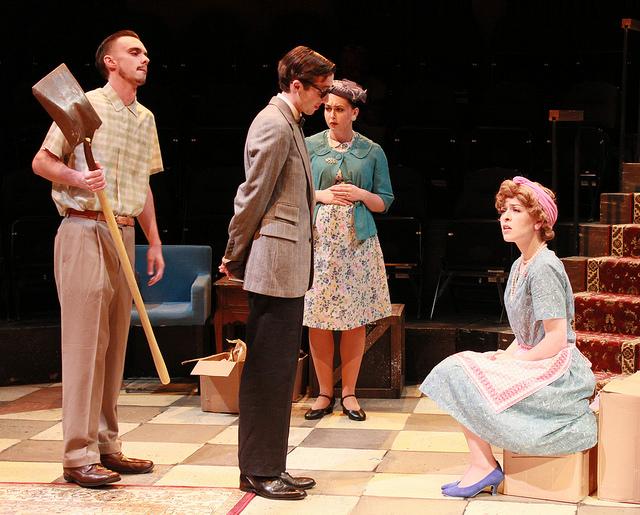From the Great Migration to gentrification: DVC presents ‘Clybourne Park’
May 18, 2016
Most millennials today probably never imagined they’d have to experience a world where racism, racial discrimination and segregation still exists.
In 2016, 106 years after the start of the Great Migration, it has been speculated among the black community that African American people are still seen as the lowest class of humans in the United States. They have perpetually been discriminated against by white people and, as a result, have been isolated into ghettos and projects. In other words, locations where most middle class white families wouldn’t dare to live.
In direct comment on these issues, Diablo Valley College drama presented “Clybourne Park,” a spin off of the popular play “A Raisin in the Sun.”
Divided into two acts, the play takes audience members back in time to a fictional neighborhood in Chicago in the 1950’s, and then back to the same neighborhood in 2009.
Act one of the play is based on a white family moving away from their white neighborhood after losing their son, and the conflict surrounding the neighborhood when the new buyers turn out to be a black family.
In the predominately white neighborhood of “Clybourne Park,” all kinds of concerns arise when they find out “Negros” will be moving in.
Are they contagious? Do white grocery stores have foods they like? If they move in will other black people move here? The general attitude of this being the end of civil community, “well there goes the neighborhood.”
In act two of the play, 48 years later, at the beginning stages of gentrification in “Clybourne Park,” a white family plans on moving into the now predominantly black neighborhood, with intentions of modernizing their new home.
The black residents of the area, who have been living in “Clybourne Park” since the Great Migration. They increasingly fear white people will take their homes and strip them away of their historical value, removing them from the neighborhood altogether. These feelings are indicative of the attitude of the neighborhood in the 1950’s when the racial rolls were reversed.
Although “Clybourne Park” is a fictional neighborhood, the play emulates real historical events that are currently still happening all across America.
Between the years of 1919 and 1970, African American people migrated to the Northeast and the Northwest to escape the increasingly dangerous environment of the South.
When black people realized they and their families didn’t have a chance to prosper, they fled in the hopes that the Northern states would bring them prosperity, equality, hope and comfort.
But when African Americans began to settle into Northern states, white people discriminated against them and moved out of the cities and into the suburbs.
This was known as the “white flight,” it left black people isolated from jobs, money and segregated blacks and whites.
As a result, cities such as Oakland and Richmond became predominantly populated by black, impoverish families.
Now African Americans face a new problem, gentrification. It’s the process of renewing and rebuilding an area with the intention of inviting wealthier people in. However, this simultaneously displaces the poorer residents of every racial background who were there initially.
Today both Oakland and San Francisco are undergoing the process of gentrification, but San Francisco seems to be the center of all the attention.
Residents who were born and raised in San Francisco are being booted out and many blame it on renter greed.
Laurie Segall, CNNMoney tech correspondent and host of CNN’s documentary on gentrification in the city, says San Franciscans working in the tech industry are making twice the amount as average workers, which adds to the increasing rent in San Francisco. If people make more money, they can pay more money to live.
Dr. Amos C. Brown, board member of the NAACP, pastor and resident of San Francisco says, “between 1970 to 1995 there were about 100,000 black people living in San Francisco, now there are only 40,000 black people.”
According to Brown, “urban renewal was black removal…there can never be wealth without the concern of the common wealth.”
As gentrification in San Francisco continues, the lower and middle class will relocate out, and will likely be pushed to cities that offer more affordable housing. And we see the ripple effects in Oakland and the surrounding areas.
Lateefah Simon, evicted from her San Francisco home in 1997, said, “gentrification is not just about housing. It’s about the way in which people live within cities.”
The play concludes in a dispute between the new white buyers and a black couple with personal ties to the house. One family stubbornly holding on to their historical ties to the home, the other wanting to rebuild the home on a larger scale, perfectly encapsulating the argument of our age.
By pushing one class out of their homes and off to somewhere else, you begin a ripple effect which continually displaces families from their roots over time. “Clybourne Park” poignantly depicts the feelings of cultural displacement and alienation surrounding gentrification in America.
Marlena Lowry, who played Lindsay in the show, pointed to the shows catalytic qualities, saying, “I hope the audience takes something away from it, that it allows them to reflect on their own lives, the words they use and how they treat other people. The characters are extreme, but there are moments when you question your own actions.”








































































